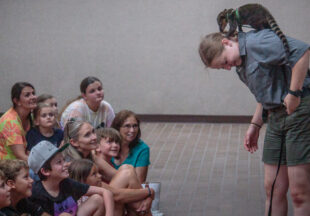Property owners, wind farm reps speak at public hearing; county commissioners accept application for tax abatements
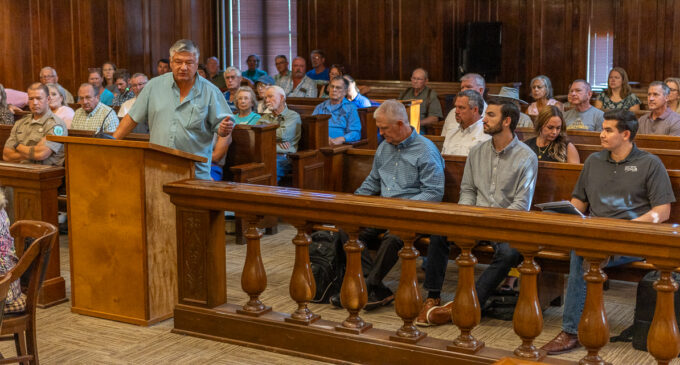
In applying for tax abatements from Stephens County, NextEra Energy Resources drew objections from many local property owners at a recent public hearing. Unresolved issues include intrusions into the new state park’s viewshed, conflicting information about military training missions, and the impact on property values.
In this story:
- Air Traffic/Military Concerns
- Palo Pinto Mountains State Park
- Other Concerns
- Background Information
- What’s Next
- Judge Michael Roach’s Concluding Comments
- Additional Reading
- Photo Gallery from the Public Hearing
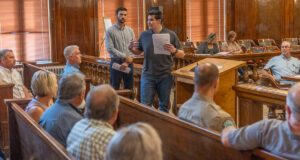
James Jowett, the NextEra Energy project manager for the La Casa wind farm, talks to the crowd of property owners at a public hearing last week. (Photo by Tony Pilkington/Breckenridge Texan)
Wind Farm proposed for southeastern Stephens County
By Tony Pilkington and Carla McKeown/Breckenridge Texan
The usually almost-empty district courtroom in the Stephens County Courthouse was crowded last Monday with local property owners and others, most of whom were in attendance for the public hearing regarding the proposed wind farm in the southeastern corner of the county.
While a typical Stephens County Commissioners Court meeting draws 10 or fewer attendees, the Aug. 21 meeting had about 50 citizens with several approaching the podium to speak during the public hearing portion of the meeting.
The hearing was held to get public input on the application filed by NextEra Energy Resources/La Casa Wind, LLC, asking Stephens County Commissioners for almost $5 million in tax abatements for the planned wind farm. NextEra filed a 438-page application dated July 11, 2023, asking the commissioners to create a reinvestment zone of approximately 15,000 acres for the proposed La Casa Wind Farm in the southeastern corner of Stephens County and for a Tax Abatements Agreement that will reduce their tax bill by an estimated $4,709,330 over a 10-year period.
According to a worksheet by NextEra, they will pay $9,655,254 in taxes to the county over the 30-year life of the proposed project. The requested tax abatements, if approved, will provide a 60 percent abatement for the first five years of the agreement and a 40 percent abatement for the following five years. NextEra predicts that their annual tax bill in 2025-2029 would range from $376,790 to $538,272. For 2030-2034, the company estimates they would make annual tax payments ranging from $262,408 to $504,630.
Both those in favor of the wind farm and those opposed to it and/or the abatements were in attendance, but only NextEra representatives spoke for the project. There were at least 12 speakers against the wind farm.
The concerns were much the same as they were last year when the wind energy company requested similar tax breaks from the school district: interference with military pilot training routes, distractions in the views at the new state park, property owners rights and objections to offering tax abatements.
Stephens County Judge Michael Roach told everyone there that the decision to be made that morning was whether or not to accept the application, not whether or not to approve the request for tax abatements. There will be additional hearings and meetings before the commissioners decide whether or not to grant the request for the tax abatements.
After almost three hours of public comments, the commissioners voted unanimously to accept the application, which is in accordance with Chapter 312 of the Texas Property Code. They will now accept written questions from the public to be presented to NextEra, and the next public hearing was scheduled for Sept. 25, when the answers to those questions are expected to be answered. Read more details about how to submit questions in the What’s Next section below.
Air Traffic/Military Concerns
One of the property owners against the wind farm, retired U.S. Army Col. Earl Brunner, spoke at the Aug. 21 hearing, bringing up the same concerns he had last year: potential interference with military plane training and testing in the area where the wind turbines are planned.
“This morning, I spoke with the manager of the air space – the military air space – before I came in here. I asked him, ‘What do I tell the judge? What do I share with the judge?’ And I quote, ‘This is a national defense issue.’ That’s what he said to me,” Brunner said.
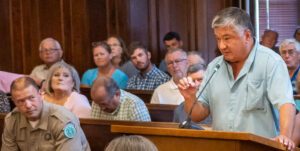
Retired U.S. Army Col. Earl Brunner explains to the commissioners why he thinks putting the proposed wind farm in the area of a military pilot training route is a bad idea. (Photo by Tony Pilkington/Breckenridge Texan)
Lockheed Martin, one of the world’s largest defense contractors, certifies aircraft that must fly as low as 500 feet, Brunner said. The planes, which come from the Naval Air Station (NAS) Fort Worth Joint Reserve Base (JRB), fly over the area where the wind farm is proposed to be located, and Brunner said that the wind turbines NextEra has planned for the area will endanger the pilots. If the wind farm is built in the proposed area, Lockheed Martin and the military will likely have to relocate the training area, Brunner said. His argument was backed up by the Texas Comptroller’s office, which rejected NextEra’s application for BISD tax breaks last year, based on the loss of revenue to the state of Texas if the training area was moved to another state.
Jake Lederle, the attorney hired by Stephens County to represent the County in the wind farm considerations, asked Brunner if his concerns would be alleviated if the U.S. Department of Defense gave NextEra permission to build the wind farm in the proposed area.
Brunner said that would not alleviate his concerns because, even if pilots flew over the area at a higher altitude, there would still be a risk of catastrophic injury if a pilot had to eject from their plane over the wind farm.
“It’s a safety issue. It’s a safety concern for all of us, for our pilots and our men and women in uniform,” he said.
Later in the meeting, James Jowett, the NextEra Energy project manager for the La Casa wind farm, spoke, and one of the first issues he addressed was the concern that the wind turbines would cause problems for training missions for NAS-Fort Worth.
He acknowledged that there had been some concerns that the wind turbines would interfere with military’s flight training because the windmills would force the Department of Defense to raise the flight ceiling to above 500 feet and the aircraft would not be able to do low-level training. He said that NextEra and the DOD had come to agreement after working out some changes and that the DOD had approved the current plan for the wind farm.
Jowett held up a copy of a letter from the Department of Defense, which he said was an agreement between NextEra Energy and the DOD stating that they were cleared to build the wind farm.
The Breckenridge Texan obtained a copy of the letter from the Stephens County Commissioners Court and noted that the DOD letter was dated Feb. 11, 2022. The attached map showed NextEra’s previous wind farm plan, not the plan that was presented in the application to the Commissioners Court.
According to the letter, the DOD and NextEra established a mitigation response team and created a plan that satisfied both parties. The letter presented to the Commissioners Court does not include the details of that plan.
In the public hearing, Jowett said that the DOD gave them an area that NextEra needed to stay away from and that NextEra had complied. However, according to a “Fort Worth Military Operating Areas and Training Routes Brochure” on the North Central Texas Council of Governments website, almost all of Stephens County is included in “military flights corridor” for low-altitude, high-speed military flight traffic and training. That area includes the area that the reconfigured NextEra project is planned for.
Also, the letter Jowett referenced was written before the Texas Comptroller of Public Accounts office rejected NextEra’s application for a Chapter 313 tax reduction from Breckenridge Independent School District last year. In a letter dated Nov. 14, 2022, the Comptroller’s office said that on Oct. 26, 2022, approximately nine months after the DOD memorandum referenced by Jowett was sent to NextEra, a military air traffic control specialist submitted objections pertaining to the proposed placement of wind turbines in the proposed area due to the cumulative effect and degradation of training capability for training pilots from Naval Air Station Fort Worth.
The letter said, “The risk assessment matrix provided illustrates a potential degraded mission capability and unit readiness, which could lead to a realignment of this training mission.”
Jowett also presented a letter from Capitol Airspace Group, which said that NextEra had 60 favorable Determinations of No Hazard from the Federal Aviation Administration (FAA) for the project. However, the letter, dated Aug. 21, 2023, which details the process and requirements from the FAA for NextEra to build the project, also references the Feb. 11, 2022, letter from the DOD that was written before the Comptroller’s rejection.
Neither letter presented by Jowett explains how NextEra is complying with the DOD requirements for the area.
Last week, the Breckenridge Texan requested a copy of the objections referenced by the comptroller’s office, but we have not yet received the information. Additionally, the Breckenridge Texan has requested an interview with someone from NAS-Fort Worth, but we have not heard if that request will be granted or not.
Palo Pinto Mountains State Park
Another topic of concern about the proposed wind farm revolves around the new Palo Pinto Mountains State Park, part of which is located in southeastern Stephens County.
At the Aug. 21 public hearing, James Adams, superintendent of the park, spoke about the impact the wind farm will likely have on the park and its visitors.
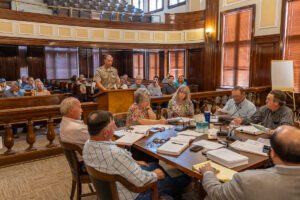
James Adams, superintendent of Palo Pinto Mountains State Park, speaks to the county commissioners about the impact the wind farm will likely have on the park and its visitors. Click here to see more photos from the public hearing. (Photo by Tony Pilkington/Breckenridge Texan)
“We’re expecting (80,000) to 100,000 visitors to the park a year. … We don’t believe that wind turbines are what folks come to state parks to see,” Adams said. “So, we do believe that a wind farm right up against our boundary would have a negative economic impact to that project and, in turn, to the surrounding counties.”
Adams presented maps to the commissioners showing that, based on maps of the proposed wind farm, at least one wind turbine will be visible in 75 percent of the park.
In an interview following the public hearing, Adams told the Breckenridge Texan that he has not been contacted by NextEra since their application for a limitation on appraised value under the provisions of Tax Code Chapter 313 was turned down by the State Comptroller’s office last year and they reconfigured the footprint of the wind farm.
He said wasn’t sure if whether they had contacted anyone else in the Texas Parks and Wildlife Department about the situation.
He said that if any of the windmills are visible from the park, it will be detrimental to the viewshed. “When I say the viewshed, I’m talking about people come to parks to experience nature and in a natural setting. They want to look at scenic vistas, and that typically would not include wind turbines,” he said. “So again, placement of any of them within the viewshed would be detrimental.”
As far as how many of the windmills would actually be visible from the park, Adams said they did a study earlier based on the original FAA application that was submitted to identify the locations; however, he said since the footprint has changed and, as the NextEra representative mentioned in the public hearing, the locations were not finite, it may not be as accurate as they would like. But, he said, using the information they had, they did as accurate a study as they could to show the number of windmills that would be visible from the park.
Maps from the study, which Adams presented to the commissioners, show that in many locations within the park, more than 50 wind turbines – with their flashing red lights – will be visible.
“What I recall is, you would be able to see at least one from about 75 percent of the park,” he said.
When asked if he thought relocating some of the turbines so they couldn’t be seen from the park would be a solution, Adams said he didn’t think that was possible. “I don’t know that that’s possible,” he said. “Because, as I said, from 75 percent of the park you’d be able to see at least one, But most places, for example our main campground, our walking campgrounds, that kind of thing, you’d be able to see several.”
In November 2022, Carter Smith, executive director of the Texas Parks and Wildlife, submitted a three-page letter to the Comptroller’s office outlining large investments that had been invested in the park project and the many economic benefits the project would bring to the area, as well as the detrimental effects the wind farm would have on the operation of the park. That information was one of the reasons cited by the Comptroller’s office last year in rejecting NextEra’s application for tax breaks from BISD under Chapter 313.
One option that has been suggested is that the wind farm could use warning lights on the turbines that are on only when an aircraft is in the area. Adams said that might be a solution to the light pollution in the park at night. “I think it would make a difference,” he said. “I don’t know that I would call it a solution, but it’s a step in the right direction, I think.”
Other concerns
At least 12 people with interests in the area of the proposed wind farm spoke at the public hearing on Aug. 21. Several others submitted letters to the commissioners court, voicing their objections to the project.
Here are some of their concerns:

Stacey Donaldson, who lives in the area of the proposed wind farm and is opposed to it, questions why no local supporters of the wind farm were at the hearing to voice their opinions. (Photo by Tony Pilkington/Breckenridge Texan)
Stacy Donaldson addressed the commissioners and the crowd in the courtroom, asking how many local residents were there in support of the wind farm. Two people were identified. “So where all these landowners that supposedly NextEra have signed contracts for? Where are they? If they want them so bad, if they need this money was so bad, where are they? Why are they not here speaking to you, saying ‘We need this desperately for our county, for our schools, for everything.’? They’re not here, there’s two…two,” Donaldson said. She said that she lives in the middle of the wind farm area and admitted that she hasn’t done surveys and didn’t have maps and other information for the commissioners. “I’m just a resident of Stephens County. I don’t want to look out my window and see these (wind turbines), plain and simple,” she said. “Don’t want to see the ugly things, don’t want to see the lights, don’t want to hear the noise. Just don’t want it around my view and obstructing my view of my property and devaluing my property.”
Caroline Esther Swanson, representing her parents, Michael and Martha Rudd, who live “right in the heart of the proposed wind farm,” addressed the issue of state and city regulations regarding wind farms and said that several related bills were presented in the last legislative session but were not voted on. “One solution for you at this time, establish a two-year moratorium on wind farms in Stephens County. The state legislature can then establish regulations, and it takes the immediate burden off of you. This also allows time for more research on your part. Local regulations would best serve the public interests of all citizens of Stephens County.”
In addition to Swanson’s public comments, the Rudds also submitted a letter addressed to Judge Roach via email. The letter briefly addressed the issues of tax abatements, the concept of “green energy” and the regulations Swanson detailed. The letter concluded with comments about the potential financial impact the wind farm could have on Stephens County: “Stephens County is poised for significant development in the next few decades according to state level projections of infrastructure. A wind farm in eastern Stephens County will be a future detriment to many, including those in favor of the farms now. Their desire for quick bucks now will cost us all in the long run, as they do not realize the long term negative impact they are asking for. Zoning laws are common. Please, I beg you give the majority some protection from unregulated destruction of land values and quality of life. There is no turning back, once the turbines are in place.”
Steve Dempsey, a long-time resident of the La Casa community in southeastern Stephens County, spoke about his dealings with NextEra and said that the company will not return his phone calls or reply to his emails. He presented a list of 51 questions that he would like NextEra to answer in writing. “One of the most troubling issues to me in dealing with NextEra is their lack of responsiveness to community concerns,” Dempsey said. “Contrary to their publicly published policies, it’s been my experience that they don’t practice transparency, community partnering and engagement, or working with the community, despite all of their printed rhetoric to the contrary.”
Dempsey asked the commissioners, “Why would you want to approve tax abatements for a company like this? They are not going to bring economic prosperity to Stephens County. They admit as much in their Chapter 312 application. Quite the contrary. They are just trying to avoid paying their fair share of taxes. They are only here for the money, the tax abatements.”

Keziah Farrar and her husband, Shane Farrar, own property in southeastern Stephens County. As a real estate agent, she says her research indicates the proposed wind farm will damage property values in the area. (Photo by Tony Pilkington/Breckenridge Texan)
Zola George, whose 320 acres are surrounded on three sides by land that has been leased to NextEra, addressed several issues, including a lack of transparency on the part of NextEra and potential decrease in property value. He said that 71 percent of the property in the proposed wind farm area is owned by two individuals. “I believe the turbines will cause a significant negative property value impact, determined to be 46 percent on one nearby wind farm study and 70 percent decrease in sales price in another study in a different area. … I believe that I stand to lose 50 to 70 percent of our property value. That’s at least a million dollar loss on our half section of land.”
George went on to point out that last year, NextEra representatives said the company would not build the wind farm if it did not receive the tax breaks from the school district under the Chapter 313 plan. “They did not get approved for that; yet, they state that they are still moving ahead. Please don’t fall for that again. And if they’re going to build the turbines anyway, then why relieve them of $4.7 million in taxes that any other business would have to pay? … I’m hoping for and respectfully asking that you have a denial of the Chapter 312 tax abatement with this list of objections and rejections.”
Keziah Farrar, who owns land in southeastern Stephens County, is a real estate agent and school board member in Mansfield. She talked to the commissioners about the effect that wind farms have on surround property values. Citing her own research as a real estate agent, she said that wind farms can cause a devaluation of about 50 percent, with some property values decreasing by as much as 70 percent. “As an elected official myself, I greatly value the time and effort you dedicate to this county. I know the decisions aren’t always easy to make, but we take an oath to do what is in the best interest of our communities that we serve. Wind turbines do not improve the quality of life for the residents and property owners of Stephens County,” she said. “Property values and future real estate development drives revenue for the county as well as the cities and school districts within this county. Wind turbines do, however, improve the quality of life for the executives at NextEra and other corporations just like them, executives that don’t live here, that don’t attend Friday night football games, or festivals in our downtown squares. They do come in and make empty promises to hardworking folks just like me and you who are left to pick up the pieces long after they’ve left the county and moved on to their next victims. Do the right thing for your residents and not NextEra.”
Joe Bradford grew up in La Casa before living in the Midwest for 30 years. He retired 13 years ago and moved back to Stephens County. He talked about what a community means and concluded with, “I think the number one reason for not wanting the windmills in the La Casa area is the majority are opposed to it, and generally majority of rules. And if you look at the reason why people want the windmills, it’s a money issue. I mean, they don’t want the windmills; they want the money.”
David Mitchell and his wife own a home and property within the proposed reinvestment zone. “In fact, there are leases north and south of us, but no way to get across us,” he said. “One question I have for NextEra – which I’ve never gotten any answers from them, and I’ve asked before – is how do they plan to get across me? Are they going to wait and let the state use eminent domain or something? I don’t know how they’re gonna hook these things up when there’s no clear path between these proposed sites with windmills.”
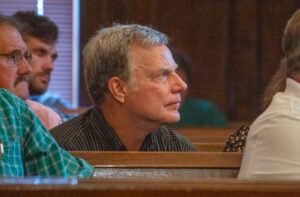
Stephens County property owner Zola George listens to speakers at the Stephens County Commissioners Court’s public hearing on a tax abatement application by NextEra Energy Resources for a wind farm. (Photo by Tony Pilkington/Breckenridge Texan)
Background Information
If this topic and the arguments surrounding it sound familiar, it’s because last year, NextEra/La Casa Wind made a similar request to the Breckenridge Independent School District.
The BISD request was through the Texas Tax Code Chapter 313 program that would have limited the value of the property that the company would have paid taxes on to $20 million, regardless of how much the property is actually valued at, for the years 2028 through 2037. Under Chapter 313, the school district would not have actually lost out on any potential tax revenues because the State of Texas would have paid BISD the difference between the taxes on the appraised value of the property and the limited value. (No such reimbursement program is involved in the abatement request for the county.)
Before the BISD school board had a chance to vote on whether or not to approve the request, the Texas Comptroller’s Office declined to issue a “certificate of limitation on appraised value” that was needed before the school district could act. The decision of the Comptroller’s Office was made because “the project would not result in a net positive benefit to the state,” according to a letter from Lisa Craven, Deputy Comptroller.
The Comptroller’s Office based their decision on two conflicts with the proposed wind farm: the new Palo Pinto Mountains State Park, part of which is located in southeastern Stephens County, and a military training mission located in Texas that, according to information the Comptroller’s Office had received, the wind turbines could interfere with.
What’s Next
The public hearing on Aug. 21 was the first of at least three hearings that the County Commissioners will hold in consideration of NextEra’s application for tax abatements for the proposed wind farm in Stephens County’s Precinct 1 in the southeastern portion of the county.

Stephens County Precinct 1 Commissioner David Fambro listens to speakers at the public hearing on Aug. 21. (Photo by Tony Pilkington/Breckenridge Texan)
At the end of the first hearing, Judge Roach and the commissioners agreed that they will collect questions from the public for NextEra and will hold another public hearing on Sept. 25 to get the answers from the company.
The public may submit their questions to the County Court through Sept. 11. Questions to be submitted to NextEra may be sent in writing to the Stephens County Commissioners Court via email to cgonzales@stephenscountytx.gov or by U.S. Mail at 200 W. Walker St., Breckenridge TX 76424.
Roach said a list of questions received will be posted on the County’s website, https://www.co.stephens.tx.us/ .
The commissioners also will have a public hearing and meeting to hold a vote on whether to create the reinvestment zone that they are required to create before they can approve any tax abatements. If the reinvestment zone is approved, then a third public hearing and commissioners court meeting will be held to vote on whether to approve the tax abatement. It wasn’t clear at Monday’s meeting if the Sept. 25 meeting will also include the hearing and meeting on the reinvestment zone.
Judge Michael Roach’s Concluding Comments
At the end of the public hearing, Roach addressed the crowd in the courtroom, explaining that he wanted to get answers to some of the questions brought up at the hearing before he decided how to vote on NextEra’s application.

Stephens County Judge Michael Roach, center, addresses the commissioners court and the crowd in the courtroom during the public hearing on Aug. 21 about an application for tax abatements by NextEra Energy Resources for a proposed wind farm in the southeastern portion of the county. (Photo by Tony Pilkington/Breckenridge Texan)
“While we’ve heard from numerous landowners in that the affected area … the county as a whole has about 10,000 residents in it,” he said. “So what we’re trying to do, what I’m trying to do as a person, is sort out what is best overall.”
Roach said he doesn’t want to make a decision about the tax abatements while there are still unanswered questions.
“I don’t like the idea of abatements in general. I don’t like public dollars going to private industries. But ladies and gentlemen, that is the way this tax system works,” he said. “We mentioned agriculture exemptions today; it’s there. The way you value an oil well; it’s there. The fact that the state gives you that and they punt it to little counties like ours because Austin don’t want to take the reins and do whatever it is they need to do. It happens all the time. How we fund our jail, they leave it to us. Austin don’t solve that problem. We have to. And so we’ve got to find creative ways to fill a hole in our budget with oil wells that are producing less. There’s not an endless supply of oil. Somewhere in this county, we’re going to have to look at long term. How do we manage, how do we provide? And I think the only way to really do that is to look at this project, to all be deliberate about it.”
Roach said that he wants to get more information and consider the impact the wind farm will have on the entire county before he makes a decision. But, because he is interested in hearing more, he voted to approve the application, stressing that his vote was not to approve the reinvestment zone or the tax abatements, just the application.
Additional Reading/Photos
Wind farm company seeks tax abatements from Stephens County; public hearing scheduled for Aug. 21
The first few pages of NextEra’s application for Stephens County tax abatements
Photo Gallery: Public Hearing on proposed wind farm tax abatement – Photos by Tony Pilkington
Column on the importance of making your voice heard by Breckenridge Texan Publisher Tony Pilkington
Cutline, top photo: Retired U.S. Army Col. Earl Brunner addresses the Stephens County Commissioners Court about the proposed wind farm in Stephens County. As a former military helicopter pilot, Brunner said he is concerned about the safety of the pilots who train in the air space over Stephens County. (Photo by Tony Pilkington/Breckenridge Texan)

































